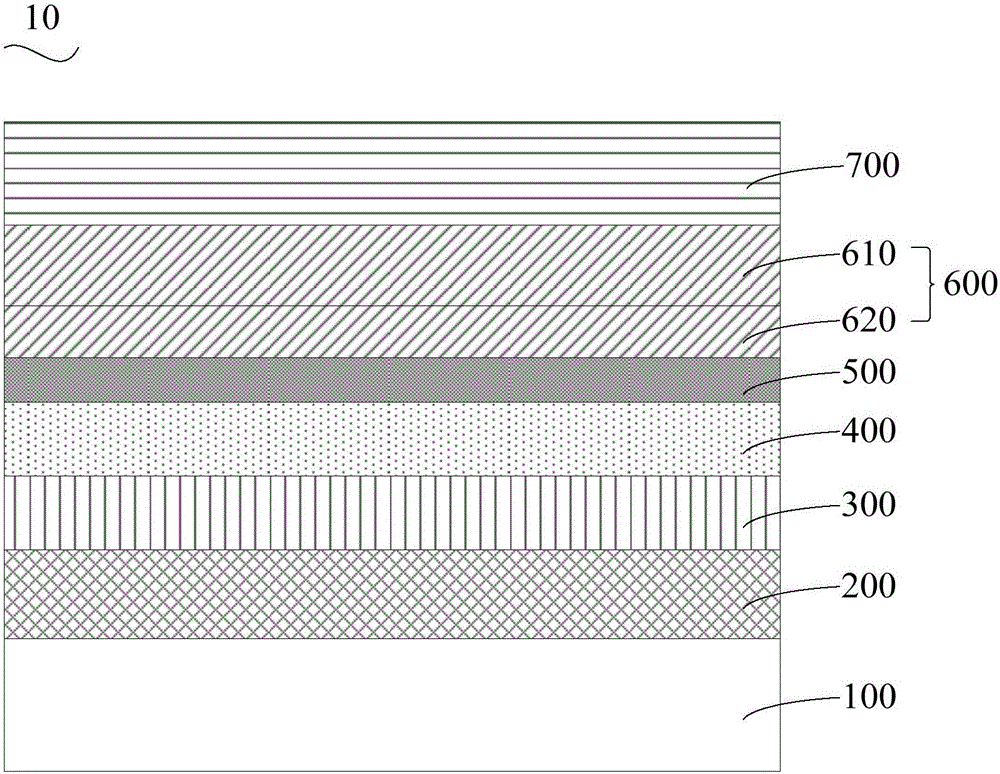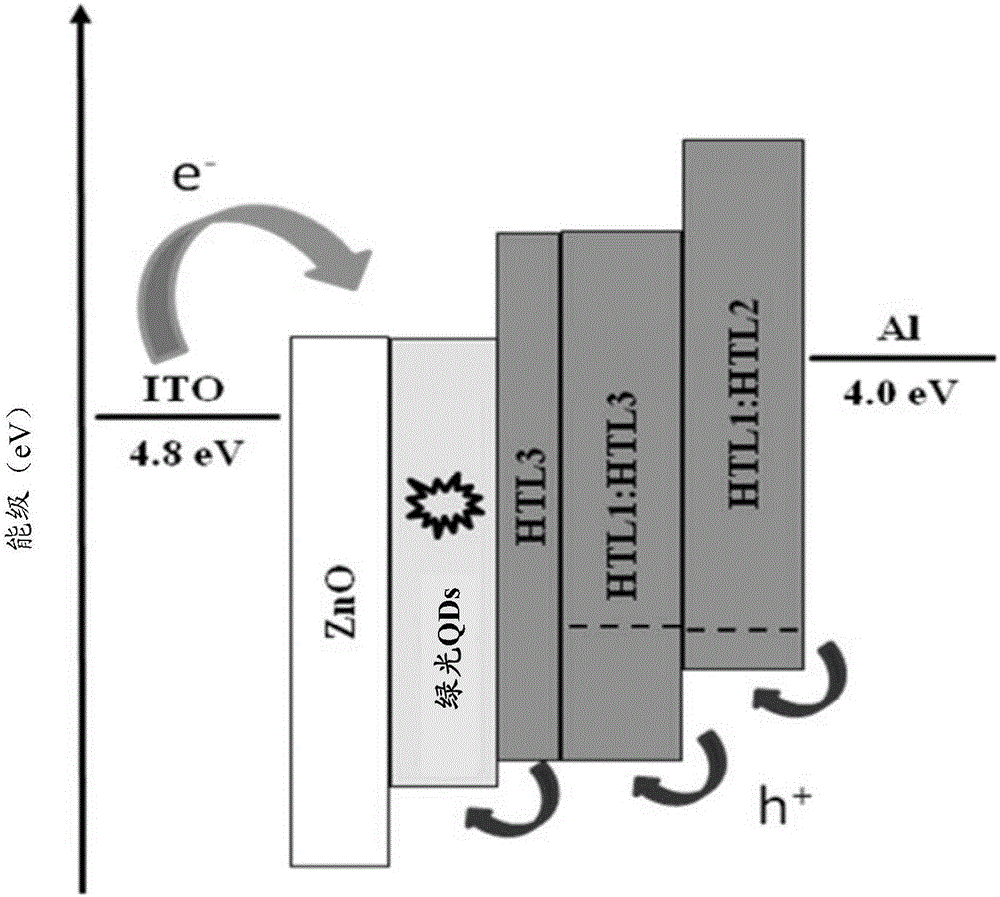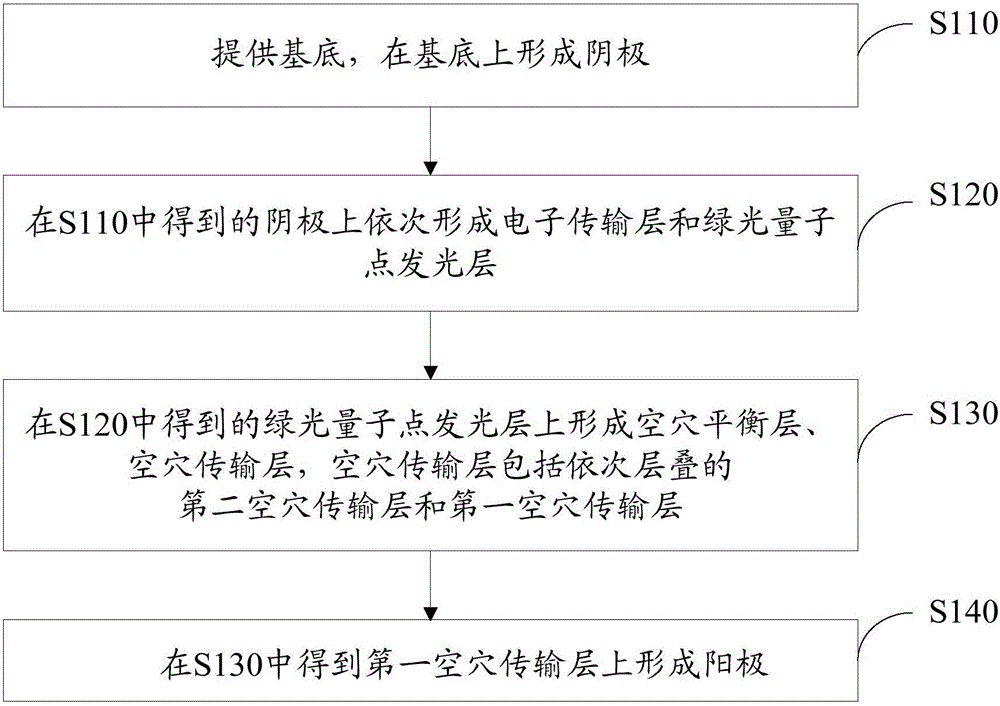Inverted green light quantum dot film electroluminescence device
An electroluminescent device, quantum dot light emitting technology, applied in the direction of electric solid devices, electrical components, semiconductor devices, etc., can solve the problems that cannot meet the requirements of hole injection, holes are not easy to inject, and the hole injection barrier is high
- Summary
- Abstract
- Description
- Claims
- Application Information
AI Technical Summary
Problems solved by technology
Method used
Image
Examples
preparation example Construction
[0049] In addition, the present invention also provides a preparation method of the above-mentioned inverted green quantum dot thin film electroluminescent device 10, such as image 3 As shown, the method includes the following steps S110-S140.
[0050] S110, providing a substrate, and forming a cathode on the substrate.
[0051] The material of the substrate can be glass, and the substrate can be ultrasonically treated with detergent, acetone, ethanol and isopropanol in sequence for 15 min each. Then, the cathode is formed by evaporation, sputtering, sputtering or electrochemical evaporation deposition on the substrate. The material of the cathode can be indium tin oxide (ITO), fluorine-doped tin oxide (FTO), aluminum-doped zinc oxide (AZO), indium-doped zinc oxide (IZO), etc., and the thickness of the cathode is 80 nm-200 nm.
[0052] Preferably, indium tin oxide (ITO) is sputtered onto the glass substrate by a sputtering method.
[0053] In this embodiment, after the cat...
Embodiment 1
[0065] The structure of the inverted green quantum dot thin film electroluminescent device is a substrate, a cathode, an electron transport layer, a green quantum dot emitting layer, a hole balance layer, a hole transport layer and an anode. The hole transport layer includes a second hole transport layer and a first hole transport layer. The second hole transport layer is in direct contact with the hole transport layer. The thickness of the hole balance layer is 8nm, and the material of the hole balance layer is the third hole transport material (HTL3), and HTL3 is 6,6-bis(4-9hydro-carbazol-9-yl)phenyl)- 6 Hydro-pyrrole[3,2,1-de]acridine (BCPPA). The thickness of the second hole transport layer is 15 nm, and the material of the second hole transport layer is a mixture formed by the first hole transport material (HTL1) and the third hole transport material (HTL3), wherein HTL1 is tungsten trioxide (HTL1). WO 3 ), HTL3 is 6,6-bis(4-9hydro-carbazol-9-yl)phenyl)-6hydro-pyrrole[...
Embodiment 2
[0071] The thickness of the hole balance layer in the inverted green quantum dot thin film electroluminescent device of this embodiment is 5 nm, the material of the hole balance layer is HTL3, and the HTL3 is BCPPA. The thickness of the second hole transport layer is 10 nm, and the material of the second hole transport layer is a mixture formed by HTL1 and HTL3, wherein HTL1 is WO 3 , HTL3 is BCPPA, WO 3 The mass ratio to BCPPA is 1:2. The thickness of the first hole transport layer is 20nm, and the material of the first hole transport layer is a mixture formed by HTL1 and HTL2, wherein HTL1 is WO 3 , HTL2 is BTPD, WO 3 The mass ratio to BTPD is 1:1. The rest are the same as in Example 1.
[0072] The specific preparation method of the inverted green quantum dot thin-film electroluminescence device is the same as that in Example 1.
[0073] The hole balance layer, the second hole transport layer and the first hole transport layer were tested respectively. The HOMO energy ...
PUM
 Login to View More
Login to View More Abstract
Description
Claims
Application Information
 Login to View More
Login to View More - R&D
- Intellectual Property
- Life Sciences
- Materials
- Tech Scout
- Unparalleled Data Quality
- Higher Quality Content
- 60% Fewer Hallucinations
Browse by: Latest US Patents, China's latest patents, Technical Efficacy Thesaurus, Application Domain, Technology Topic, Popular Technical Reports.
© 2025 PatSnap. All rights reserved.Legal|Privacy policy|Modern Slavery Act Transparency Statement|Sitemap|About US| Contact US: help@patsnap.com



